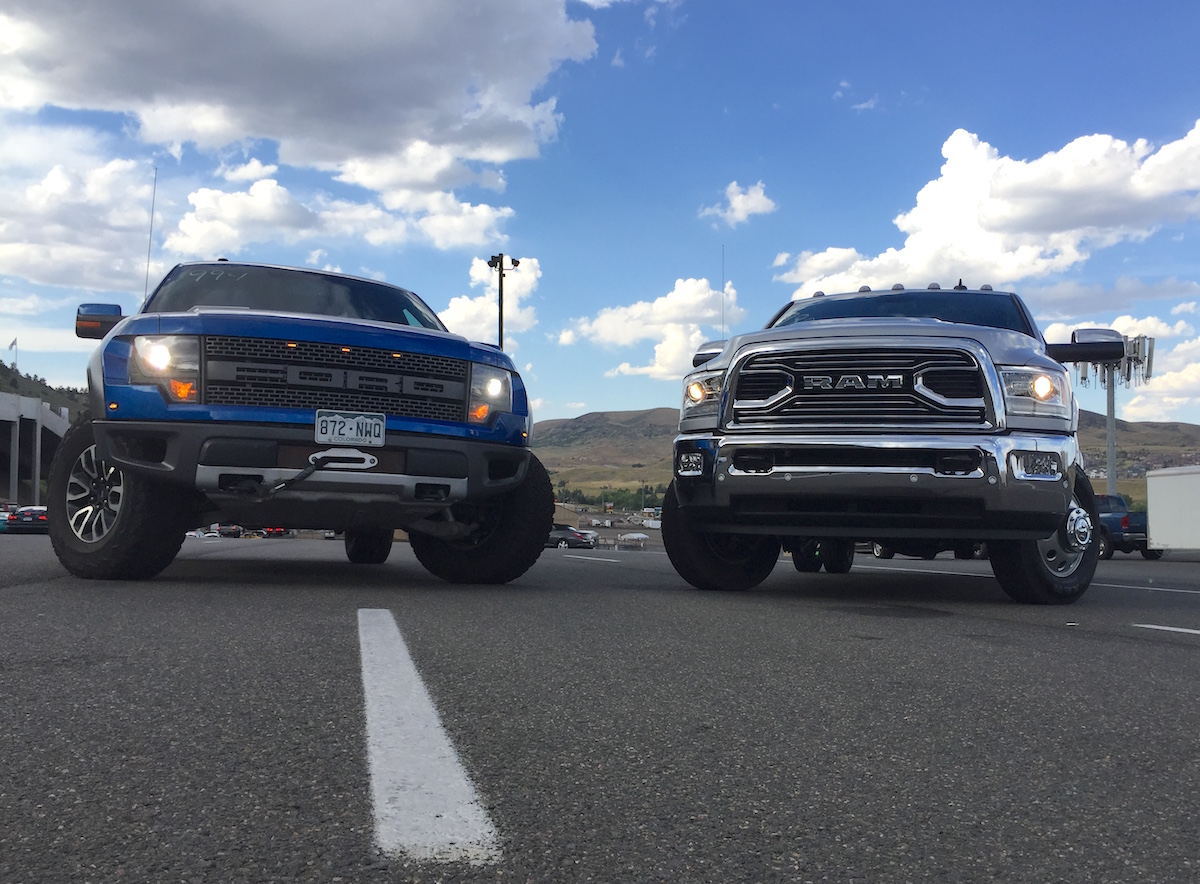
What would happen if you put a half-ton truck (2021 Ford F-150 Hybrid) and a heavy-duty truck (2021 Chevy Silverado HD 2500 Diesel) on the world’s toughest towing test with a 10,000 lbs trailer? There is only one way to find out! Let’s do it!
Ike Gauntlet / Vail Gauntlet
The Ike Gauntlet™ route is closed for construction and road repairs during this run. Thus, we run another super tough mountain pass – the Vail Gauntlet. The Vail pass is just a few miles away from the Ike Gauntlet. The Vail Gauntlet (west side) is a 10-mile climb to a total elevation of 10,603 feet above sea level. This pass has several section with steep 7% grades, and the road surface is very rough.
Ford F-150
This new 2021 F-150 is equipped with a 3.5-liter twin-turbo V6 engine that is combined with an electric motor and a 10-speed automatic transmission. The total power rating is 430 hp and 570 lb-ft of torque. This F-150 crew cab 4×4 is rated at 1,708 lbs of maximum payload and 11,000 lbs of towing capacity.
Chevy HD 2500
The 2021 Chevy Silverado 2500 HD crew cab 4×4 is packing a 6.6-liter V8 turbo-diesel. The power rating is 445 hp and 910 lb-ft of torque. The Silverado uses a 10-speed HD automatic transmission. This truck is rated to tow 18,700 lbs and has a much more usable payload of over 3,050 lbs.
The Load
We are pulling a 22-foot flat-deck trailer with a tilt deck and many accessories. Mr. Truck equipped this trailer with two tool boxes, a winch, and much more. On top, we parked our 1965 Ford F-100 project truck. It’s tied down with four chains, and the total trailer weight is super close to 10,000 lbs.
Which truck should you buy to tow a trailer like this? A capable half-ton or a much-larger heavy-duty truck? Here are the surprising results from our Vail Gauntlet test. It is a very hot summer day with an ambient temperature on top of the mountain of 81-F.
Uphill
The 2021 Chevy Silverado 2500 HD completed the hill-climb in 9 min 25 seconds with a computer-reported 4.9 MPG on the uphill section. All oil and coolant temperatures were in their normal operating ranges. There were no signs of overheating or abnormal behavior with this Silverado. Once again, since this was our first Vail Gauntlet – you cannot compare this to any other Ike Gauntlet results from the last 8 years. Still, we can compare it against the F-150 here.
The F-150 pulled the same load up the mountain in 9 min 45 seconds with a computer-reported 3.8 MPG. The F-150’s engine coolant and transmission fluid temperature reached very close to “Hot” levels on their respective gauges. It was very close to overheating. The F-150 delivered a warning message “Power Reduced to Lower Engine Temp”. We definitely felt the reduced power as the truck and trailer were slowing down near the top of the mountain. The decision was made to keep going and complete the climb.
The F-150’s engine management computer protected the truck from serious damage and overheating, but this shows that the half-ton truck was working near or at its limit.
Ford’s latest owner’s manual states the following: “Note: Your vehicle could have reduced performance when operating at high altitudes and when heavily loaded or towing a trailer. When driving at elevation, to match driving performance as perceived at sea level, reduce gross vehicle weight and gross combination weight by 2% per 1,000 ft (300 m) elevation.“
The F-150’s Gross Combined Vehicle Weight (GCWR) is 17,000 lbs. The truck+trailer+people weight for this test was 16,100 lbs. According to Ford’s manual, we needed to reduce our GCWR to around 15,300 lbs for the Vail Gauntlet altitude. Still, the truck’s J-2807 towing rating should apply no matter where you are across the country or anywhere on earth.
Downhill
This was our first time measuring the downhill performance on the Vail Gauntlet. The profile of this 10-mile downhill run looks much like a staircase. There are some very steep grades following by relatively flat plateaus. As always, we measure downhill performance by counting brake applications. This time our speed range is 55 – 65 MPH. The speed limit is 65 MPH on this stretch of highway.
The Chevy HD diesel is equipped with an exhaust brake and a good grade shifting transmission tuning. The Chevy HD had no issues controlling this load down the mountain. At times it was providing too much braking force. This required us to speed up to our desired minimum speed of 55 MPH. In the end, we counting 8 brake applications in the Chevy. This is still a good performance, but it would have been better if the truck would better maintain the minimal speed and not slowed us down too much.
The Ford F-150 uses regenerative braking and a good grade shifting algorithm to control downhill driving with a trailer. The truck and trailer felt good on the way down, although there was a bit more lateral movement from the F-150’s suspension. The F-150 registered 12 brake applications on the way down, and the brakes got hotter than on the Chevy when we reached the bottom.
Verdict
While both of these trucks completed this tough towing test, the heavy-duty truck did it with lots of capability in reserve and less wear and tear. The half-ton truck got close to overheating and received more wear and tear on this run. If you are towing less than 10,000 lbs occasionally – then a half-ton truck like this would work fine. If you are towing 10,000 lbs or more, and plan to do it on a somewhat regular basis – then a heavy-duty truck is a much better choice. Keep in mind that the HD truck will likely cost more.
The price of this F-150 XL crew cab 4×4 FX4 is close to $52,000. The price of this well-equipped Chevy Silverado HD 2500 LTZ Diesel is around $74,000. You can configure both of these trucks at around $60K-$65K with options.
















![Which is More Reliable: 3.5L EcoBoost or 5.0L V8? [Reader Question] Second-generation 3.5-liter EcoBoost engine](https://tfltruck.com/wp-content/uploads/2016/05/Second-generation-35-liter-EcoBoost-engine.jpg)
![Which Silverado Engine to Get: 5.3L or 6.2L V8? [Ask TFLTruck] 2016 chevy silverado](https://tfltruck.com/wp-content/uploads/2015/10/2016-chevy-silverado-grille.jpg)
